Swaminarayan Sampradaya
The Swaminarayan Sampradaya is a Hindu sampradaya which was founded in 1801 by Sahajanand Swami, also known as Swaminarayan, who was worshipped as God by thousands of followers. Under Swaminarayan’s leadership the sampradaya grew to more than 100,000 followers and 3,000 swamis (monks) by the time of his death in 1830.
| Part of a series on | |
| Hindu philosophy | |
|---|---|
 | |
| Orthodox | |
|
|
|
| Heterodox | |
|
|
|
|
|
|
| Part of a series on |
| Vaishnavism |
|---|
 |
|
Holy scriptures
|
|
Sampradayas
|
|
Related traditions |
|
|
In the 20th century, due to "different interpretations of authentic successorship,"[1] the sampradaya split-up into various denominations, the largest being the BAPS.[2] All groups regard Swaminarayan as God but differ in their theology and the religious leadership they accept.[3][4][5]:172[6] The Vadtal Gadi and Ahmedabad Gadi are the oldest institutions, with a hereditary leadership which appoints acharyas. According to Paramtattvadas, belonging to the BAPS, Swaminarayan established two modes of succession: a hereditary administrative mode through a document titled the ‘Lekh’; and a spiritual mode established in the Vachanamrut, in which Swaminarayan conveyed his theological doctrines.[4]:132–156 The BALS venerates "a lineage of akṣaragurus, or living gurus, [which] has been retroactively traced back to Gunatitanand Swami."[2]
Due to the commentarial work of Bhadreshdas Swami, Swaminarayan's teachings were recognized as a separate school of Vedanta by the Shri Kashi Vidvat Parishad in 2017[7][8] and by members of the 17th World Sanskrit Conference in 2018.[9][note 1][10]
In the Vachanamrut, the principal theological text of the sampradaya,[4]:6 Swaminarayan identifies five eternal and distinct entities: Parabrahman, Aksharbrahman, maya (māyā), ishwar (iśvara), and jiva (jīva).[11]:319[12]:244[4]:69–71[note 2] He further explains that the ultimate goal of life is moksha (mokṣa), a spiritual state of ultimate liberation from the cycle of births and deaths that is characterized by eternal bliss and devotion to God. Moksha can be achieved during one’s human life under the guidance of the manifest form of God, the Aksharbrahman Guru.[4]:74–84, 303–304[12]:239–40[14]:166–9
The Guru helps the follower practice and master ekantik dharma, which consists of dharma (dharma, religious and moral duties), gnan (jñāna; knowledge of God and the atman), vairagya (vairāgya; dispassion for worldly objects), and bhakti (bhaktī; devotion)[4]:74–84, 303–304[12]:239–40[14]:166–9[15] Another important practice is the chanting the Swaminarayan mantra, a compound of Swami (Akṣarabrahman, also Akshara, Akṣara, or Brahman, God's ideal devotee), and Narayana (Parabrahman or Puruṣottama, God).[3] Both the religious group and its leader became popularly known by this mantra.[3] As followers accepted this name, some began to consider the Swaminarayan mantra to refer to Sahajanand Swami as Purushottam (God).[3][16]:93
Swaminarayan instituted the sampradaya’s mandir tradition to facilitate followers’ devotional worship of God.[17]:65[18]:353 During his lifetime, Swaminarayan constructed six mandirs: Ahmedabad (1822), Bhuj (1823), Vadtal (1824), Dholera (1826), Junagadh (1828), and Gadhada (1828). Swaminarayan’s successors have continued the tradition of installing images of God and his ideal devotee to help devotees in their ultimate aim of moksha.
Socially, Swaminarayan’s doctrine that everyone’s true self is the atman within which God resides, led him to reject caste-based discrimination within the religious community. Swaminarayan also inspired followers to engage in humanitarian service activities, leading various denominations of the Swaminarayan Sampradaya to currently provide humanitarian service globally.
History
Sahajanand Swami
The Swaminarayan Sampradaya takes its name and origin from its historical founder, Swaminarayan, also known as Sahajanand Swami.[4]:1[19] Swaminarayan was born on 3 April 1781 in the village of Chhapaiya in present-day Uttar Pradesh, India.[4][20]:8–9 After his parents’ death, he renounced his home at the age of 11 and traveled for 7 years as a child yogi around India before settling in the hermitage of Ramanand Swami, a Vaishnava religious leader in present-day Gujarat.[4]:1[20]:8 [21]:101 Ramanand Swami initiated him as Sahajanand Swami on 28 October 1800 and appointed him to be his successor and the leader of his Uddhav sampradaya in 1801.[21]:101[18]:126
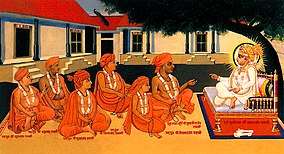
Ramanand Swami died on 17 December 1801.[16]:386 Soon thereafter, Sahajanand was regarded as the manifestation of God, being called Swaminarayan, a name which was also given to his followers as a mantra.[22] The word Swaminarayan is a compound of two Sanskrit words: Swami (Svāmī) and Narayan (Nārāyaṇa). According to the Ahmedabad and Vadtal diocees, the name refers to one entity, Purushottam,[23] According to the BAPS-tradition, Swami denotes Aksharbrahman (God's ideal devotee), namely Gunatitanand Swami, as identified by Sahajanand Swami, and Narayan denotes Parabrahman (God), a reference to Sahajanand Swami himself.[1][24] This understanding recalls an earlier Vaishnava tradition of the divine companionship between the perfect devotee and God (for example, Radha and Krishna or Shri and Vishnu).[25]:92
Both the religious group and its leader, Sahajanand Swami, then became popularly known by the mantra they chanted, Swaminarayan.[3] As followers accepted this name, they considered the Swaminarayan mantra to refer to Sahajanand Swami as Purushottam (God),[1][16]:93 and during Swaminarayan’s life, he was worshiped as God by thousands of followers.[26]:xvii
The sampradaya grew quickly over the 30 years under Swaminarayan’s leadership, with British sources estimating at least 100,000 followers by the 1820s.[4]:1 [21]:101 It continued to grow after Swaminarayan’s death (1 June 1830), with an estimated 288,000 followers by 1872.[21]:102[25]:23
Early monasticism
Challenged by the growth of the Swaminarayan Sampradaya, some religious and political leaders persecuted Swaminarayan and his followers, particularly his swamis (monks). Swaminarayan had instructed the swamis to maintain an austere code of conduct as part of their spiritual practice. This code of conduct included refraining from retaliation when harassed by others, which left them vulnerable to physical assault. To help them escape such harassment, Swaminarayan ordained 500 swamis into the highest monastic order as paramhansas (paramhaṃsas), thereby allowing them to temporarily suspend certain practices, like applying sacred marks, that allowed opponents to identify them as one of his followers.[18]:207[25]:24–25[3] Altogether, Swaminarayan ordained 3,000 swamis over the span of his leadership.[3][4]:1
The swamis expressed their devotion to Swaminarayan in various ways, ranging from composing bhakti poetry to authoring scriptural commentaries.[27]:198–214[28]:218–230[29]:142–143 Swaminarayan also encouraged his swamis to serve others. During the devastating famine of 1813-14 in Kathiawar, for example, the swamis collected alms in unaffected regions of Gujarat to distribute among the afflicted.[20]:17[25]:26
Beliefs
Swaminarayan’s teachings are found in the Vachanamrut (Vacanāmṛta), the principal theological text of the Swaminarayan Sampradaya.[30] As followers believe Swaminarayan to be Parabrahman (Parabrahman, or Purushottam, Puruṣottama), his teachings are considered a direct revelation of God.[31] In the Vachanamrut, Swaminarayan describes that the ultimate goal of life is moksha (mokṣa), a spiritual state of ultimate liberation from the cycle of births and deaths and characterized by eternal bliss and devotion to God.[32][33]:13, 173 According to Brahmbhatt, "Sahajanand explicitly states that his school of Vedanta is Ramanuja's Vishishtadvaita," but that "he also states that his system of devotional praxis is based on the Vallabha tradition."[34] Yet, Brahmbhatt also notes that "Sahajanand Swami indirectly acknowledges that there is a difference between his system and Ramanuja's." Whereas Ramanuja describes three eternal entities, "Sahajanand Swami's unique system describes five."[34]
Metaphysics
While his preference for Ramunaja’s theology is stated in the sacred text, the Shikshapatri (Śikṣāpatrī), Swaminarayan actually teaches a significantly different system of metaphysics in the Vachanamrut. In Ramunaja’s system, there are three entities: Parabrahman, maya (māyā), and jiva (jīva).[29]:141–2[14]:157–60[33]:183–4[27]:211 Throughout the Vachanamrut, Swaminarayan identifies five eternal and distinct entities: Parabrahman, Aksharbrahman (Akṣarabrahman, also Akshara, Akṣara, or Brahman), maya, ishwar (īśvara), and jiva.[11]:319[12]:244[35][36]
Parabrahman is God, who is sarvopari (sarvoparī, transcends all entities), karta (kartā, omniagent), sakar (sākār, possesses an eternal and divine form), and pragat (pragat, forever manifests on Earth to liberate spiritual seekers).[4]:71,75,109 [37] Swaminarayan identified himself as Parabrahman.[4]:152–156[38]
Aksharbrahman, is the second highest entity and has four forms: 1) Parabrahman’s divine abode, 2) the ideal devotee of Parabrahman eternally residing in that divine abode, 3) the sentient substratum pervading and supporting the cosmos (chidakash, cidākāśa), and 4) the Aksharbrahman Guru, who serves as the manifest form of God on earth through whom God guides aspirants to moksha.[39][14]:156, 165–9[40]:131 This understanding of Akshar having four forms is one of the features that distinguishes Swaminarayan’s theology from others.[14]:169[12]:245[33]:172–90 In Vachanamrut Gadhada I-63, Swaminarayan emphasizes the need to understand Akshar in order to understand God (Parabrahman) perfectly and completely.[14]:162
Maya refers to the universal material source used by Parabrahman to create the world.[41][42] Maya has three gunas (guṇas, qualities) which are found to varying degrees in everything formed of it: serenity (sattva), passion (rajas), and darkness (tamas).[43][44] Maya also refers to the ignorance which enshrouds both ishwars and jivas, which results in their bondage to the cycle of births and deaths (transmigration) and subsequently suffering.[11]:320[45][46]:388–9[47]
Ishwars are sentient beings responsible for the creation, sustenance, and dissolution of the cosmos, at the behest of Parabrahman.[48][11]:320[49] While they are metaphysically higher than jivas, they too are bound by maya and must transcend it to attain moksha.[50][27]:215[46]:388–9[51]
Jivas, also known as atmans, are distinct, eternal entities, composed of consciousness that can reside in bodies, animating them. The jiva is inherently pure and flawless, though under the influence of maya, jivas falsely believe themselves to be the bodies they inhabit and remain bound to the cycle of transmigration.[52][11]:320–1[46]:388–9[53]
Moksha
In Swaminarayan’s soteriology, the ultimate goal of life is moksha, a spiritual state of ultimate liberation from the cycle of births and deaths. The jiva attains this state, characterized by eternal bliss and devotion to God, by becoming brahmarup (brahmarūp), or like Aksharbrahman, under the guidance of the manifest form of God, the Aksharbrahman Guru.[4]:74–84, 303–304[12]:239–40[14]:166–9[54]
To attain moksha, an individual must overcome the ignorance of maya, which Swaminarayan describes as self-identification with the physical body, personal talents, and material possessions.[4]:273–4[55]
Swaminarayan then explains that an individual must earn the grace of Parabrahman and Aksharbrahman through a spiritual endeavor called ekantik dharma (ekāntik dharma). Ekantik dharma consists of dharma (dharma; religious and moral duties), gnan (jñāna; realization of the atman and Paramatman) vairagya (vairāgya; dispassion for worldly objects), and bhakti (bhakti; devotion to God coupled with the understanding of God’s greatness).[4]:287[12]:247[56]:126[57]
By pleasing the Aksharbrahman Guru with one’s efforts, Swaminarayan states that an individual perfects ekantik dharma and acquires virtues of Aksharbrahman, becoming brahmarup.[4]:275, 286[12]:247[58] In this highest state, the jiva or ishwar never becomes Aksharbrahman but transcends maya and experiences God’s bliss through eternally serving Parabrahman.[4]:277, 303–4[12]:246–7
Recognition as distinct school of Vedanta
The Shri Kashi Vidvat Parishad, a highly eminent scholarly council for adjudicating matters of Vedic studies and tradition throughout India, stated in a meeting in Varanasi on 31 July 2017 that it is "appropriate to identify Sri Svāminārāyaṇa’s Vedānta by the title: Akṣarapuruṣottama Darśana,"[note 3] and that his teachings are "distinct from Advaita, Viśiṣṭādvaita, and all other doctrines." They also stated that "Mahāmahopādyāya Sadhu Bhadreshdas is an ācārya and a contemporary commentator in the lineage of commentators on the Prasthānatrayī."[7][8]
Akshar-Purushottam Darshan was also recognised as a distinct school of Vedanta in 2018, by members of the 17th World Sanskrit Conference.[9][note 1][10] Paramtattvadas Swami describes Swaminarayan's teachings as "a distinct school of thought within the larger expanse of classical Vedanta,"[59] presenting Swaminarayan's teachings as a seventh school of Vedanta.[60]
Practices
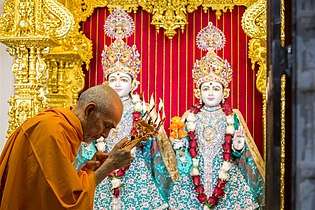
Some of the practices that Sahajanand Swami instituted reflected those of Vaishnava and Krishnite traditions.[61]
Ekantik dharma
Ekantik dharma (ekāntik dharma) is an important spiritual practice of the Swaminarayan Sampradaya, and its establishment is one of the reasons why Swaminarayan is believed to have incarnated.[62] Ekantik dharma consists of dharma, gnan, vairagya, and bhakti.[63][12]:247[56]:126 [64]
Dharma consists of religious and moral duties according to one’s responsibilities and situation.[65] All Swaminarayan Hindus who are householders maintain five basic vows: abstaining from theft, gambling, adultery, meat, and intoxicants like alcohol.[25]:174[66]:344 As part of their dharma, swamis additionally endeavor to perfect the five virtues of non-lust (nishkam/niṣkāma), non-greed (nirlobh/nirlobha), non-attachment (nissneh/nissneha), non-taste (niswad/nissvada), and non-ego (nirman/nirmāna).[25]:165–174[14]:166 Another aspect of the practice of dharma is the Swaminarayan diet, a type of vegetarianism, similar to that practiced generally by Vaishnava sampradayas, that entails abstaining from animal flesh, eggs, onions, and garlic.[25]:174
Gnan is knowledge of Parabrahman and realizing oneself as the atman. Basic practices of gnan include the daily study of scriptures like the Vachanamrut and Shikshapatri and weekly participation in congregational worship services (sabha/sabhā) at the mandir (temple), in which scriptural discourses geared towards personal and spiritual growth occur.[67]:107 In the Vachanamrut, Swaminarayan explains that adhering to the Aksharbrahman Guru’s commands is commensurate to perfectly embodying gnan—that is, realizing oneself as the atman.[68][69]

Vairagya is dispassion for worldly objects, through practices like fasting on Ekadashi days, two of which occur every month, and observing extra fasts, during the holy months of Chaturmas (a period of four months between July and October)[25]:169–170 Vairagya is realized by adhering to the codes of conduct, inclusive of these practices, serving other devotees physically, listening to discourses, and engaging in devotion.[70][71]
Bhakti involves devotion towards God, while understanding God’s greatness and believing oneself—the atman—as one with Aksharbrahman.[72][73] Important bhakti rituals for Swaminarayan Hindus include puja (pūjā; personal worship of God), arti (ārtī; the ritual waving of lighted wicks around murtis, or images), thal (thāl; the offering of food to murtis of God), and cheshta (ceṣtā; the singing of devotional songs that celebrate the divine acts and form of Swaminarayan).[74]:861
During puja, adherents worship Swaminarayan and, depending on their denominational affiliation, the lineage of Aksharbrahman Gurus through whom Swaminarayan is believed to be manifest, by performing a series of ritual acts before their murtis.[40]:132
At the beginning of the puja ritual, men imprint a symbol known as the tilak chandlo on their forehead, and women imprint a chandlo.[75]:44 The tilak is a u-shaped saffron-colored symbol made of sandalwood, symbolizing God’s feet, and the chandlo is a red symbol made of kumkum, symbolizing God’s ideal devotee.[75]:44
Other bhakti rituals included in Swaminarayan religious practice are abhishek (abhiśeka), the bathing of a murti of God,[25]:140 mahapuja (māhāpūjā), a collective worship of God usually performed on auspicious days or festivals,[74]:852 and mansi (mānsi) puja, worship of God offered mentally.[76]:91
Mandir tradition
The Swaminarayan Sampradaya is well-known for its mandirs, or Hindu places of worship.[77]:64 From Swaminarayan’s time through the present, mandirs functioned as centers of worship and gathering as well as hubs for cultural and theological education.[78]:263[79]:377 They can vary in consecration rituals and architecture, which can be adapted to the means of the local congregation.[79]:367
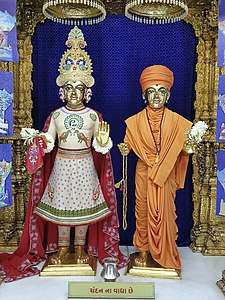
History
Swaminarayan instituted the mandir tradition of the sampradaya to provide followers a space for devotional worship (upasana, upāsanā) to God.[17]:65[18]:353 He constructed six mandirs in the following locations: Ahmedabad (1822), Bhuj (1823), Vadtal (1824), Dholera (1826), Junagadh (1828), and Gadhada (1828).[78]:263–264 Swaminarayan installed the murtis, or sacred images, of various manifestations of God and his devotee in the central shrines of each of these mandirs.[78]:264 He also installed his own image in the form of Harikrishna in the mandir at Vadtal, signifying his own divinity.[80]:198[81]:253[18]:370 Swaminarayan’s successors have continued the tradition of installing murtis of God (Swaminarayan) and his ideal devotee to facilitate his followers’ pursuit of moksha.[79]:363
Murti puja
The Swaminarayan Sampradaya is a bhakti tradition that believes God possesses an eternal, divine, human-like, transcendent form.[82] Thus, Swaminarayan mandirs facilitate devotion to God by housing murtis which are believed to resemble God’s divine form.[83]:236 The murtis are consecrated through the prana pratishta (prāṅa pratiṣṭha) ceremony, after which God is believed to reside in the murtis. Consequently, the worship practiced in Swaminarayan mandirs is believed to directly reach God.[83]:236
After the consecration of a mandir, various rituals are regularly performed in it. Arti is a ritual which involves singing a devotional song of praise, while waving a flame before the murtis. Arti is performed five times per day in shikharbaddha mandirs and twice per day in hari mandirs. Thal, a ritual offering of food to God accompanied by devotional songs, is also regularly offered three times per day to the murtis in Swaminarayan mandirs. The sanctified food is distributed to devotees after the ritual.[25]:148–149
Devotees also engage with the murtis in a Swaminarayan mandir through other worship rituals, including darshan, dandvat, and pradakshina. Darshan is the devotional act of viewing the murtis, which are adorned with elegant clothing and ornaments.[25]:133 Dandvats (daṇdavat), or prostrations, before the murtis symbolize surrendering to God.[25]:138 Pradakshina (pradakṣiṇā), or circumambulations around the murtis, express the desire to keep God at the center of the devotees’ lives.[25]:137
Community building and worship
Swaminarayan mandirs also serve as hubs for congregational worship and theological and cultural education.[77]:65–66 Singing devotional songs, delivering katha (sermons), and performing rituals such as arti all occur daily in Swaminarayan mandirs. In addition, devotees from the surrounding community gather at least once per week, often on a weekend, to perform these activities congregationally.[66]:341, 344–345
Cultural and theological instruction is also delivered on this day of weekly congregation. Cultural instruction may include Gujarati language instruction; training in music and dance; and preparation for festival performances.[79]:377 Theological instruction includes classes on the tradition’s history and doctrines, and the life and work of the tradition’s gurus.[77]:66
Types of Swaminarayan mandirs
Swaminarayan followers conduct their worship in various types of mandirs. The homes of Swaminarayan devotees contain ghar mandirs, or home shrines, which serve as spaces for the daily performance of worship and ritual activities such as arti, thal, and reading sermons or scripture.[25]:145–147
The majority of freestanding public Swaminarayan mandirs are hari mandirs, whose architectural style and consecration rituals are adopted to the means available to the local congregation.[77]:64
As a means of expressing their devotion to Swaminarayan and their guru, some congregations elect to construct stone, shikharbaddha mandirs following Hindu architectural scriptures.[79]:366–367 In addition to being an expression of devotion, congregants strengthen their sense of community by cooperatively volunteering to construct these mandirs.[79]:370
A fourth type of mandir, called a mahamandiram (mahāmandiram) can be found in India, in New Delhi and Gandhinagar, Gujarat.[77]:68[46]:384[84]:46 These mahamandirs are the largest type of mandir constructed and they contain exhibits which present the life of Swaminarayan and the history of Hinduism in various formats with the goal of inspiring introspection and self-improvement.[46]:392–398
Scriptural tradition
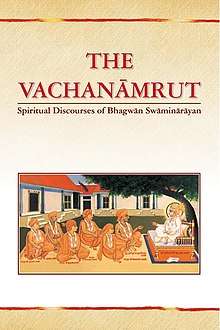
In addition to Swaminarayan’s acceptance of perennial Hindu texts such as the Vedas, Vedanta-sutras, and the Bhagavad Gita, Swaminarayan encouraged the creation of a scriptural tradition specific to the Swaminarayan Sampradaya.[85][25]:200 In addition to theological texts with revelatory status, the genres of textual production in the Swaminarayan Sampradaya include sacred biographies, ethical precepts, commentaries, and philosophical treatises.[86][87]:133
Vachanamrut
The Vachanamrut, literally the ‘immortalizing ambrosia in the form of words’, is the fundamental theological text of the Swaminarayan Sampradaya owing to the followers’ belief that Swaminarayan himself is the self-manifestation of Parabrahman. The text is a compilation of 273 discourses, with each discourse within the collection also called a Vachanamrut.[88] Swaminarayan delivered these discourses in Gujarati between the years of 1819-1829, and his senior disciples noted his teachings while they were delivered and compiled them during Swaminarayan’s lifetime.[89] In this scripture, Swaminarayan outlines his system of metaphysics which includes five eternal entities: jiva, ishwar, maya, Aksharbrahman, Parabrahman.[90][12]:244 He also describes the ultimate goal of life, moksha (mokṣa), a spiritual state of ultimate liberation from the cycle of births and deaths and characterized by eternal bliss and devotion to God.[32][33]:13, 173 To attain this state, Swaminarayan states that the jiva needs to follow the four-fold practice of ekantik dharma[91] under the guidance of the Aksharbrahman Guru to transcend maya[92][93] and become brahmarup[12]:247 to reside in the service of God.[94][12]:246
As followers believe Swaminarayan to be God, the Vachanamrut is considered a direct revelation of God and thus the most precise interpretation of the Upanishads, Bhagavad Gita, and other important Hindu scriptures.[31][33]:173 This scripture is read by followers regularly and discourses are conducted daily in Swaminarayan temples around the world.[95]:217
Swamini Vato
The Swamini Vato is a compilation of teachings delivered by Gunatitanand Swami over the course of his forty-year ministry.[96] Gunatitanand Swami was one of Swaminarayan’s foremost disciple.[56]:119[96] According to some denominations of the Swaminarayan Sampradaya, he was the first spiritual successor to Swaminarayan.[26]:xviii[25]:61 Similar to the Vachanamrut, Gunatitanand Swami’s followers recorded his teachings, which were compiled in his lifetime and reviewed by Gunatitanand Swami himself.[96] The text consists of approximately 1,478 excerpts taken from Gunatitanand Swami’s sermons.[97]:16 In his teachings, Gunatitanand Swami reflects on the nature of human experience and offers thoughts on how one ought to frame the intentions with which they act in this world, while also elaborating on Swaminarayan’s supremacy, the importance of the sadhu, and the means for attaining liberation.[97]:123 Often, Gunatitanand Swami elaborates upon topics or passages from the Vachanamrut, which lends the text to be considered a ‘natural commentary’ on the Vachanamrut within the Swaminarayan Sampradaya. In addition, he often made references to other Hindu texts, parables, and occurrences in daily life in order not only to explain the sophisticated concepts, but also to provide guidance on how to live them.[98]
Shikshapatri
The Shikshapatri is a composition of 212 Sanskrit verses attributed to Swaminarayan and completed in 1826.[21]:101 As an ‘epistle of precepts,’ the verses primarily communicate the Swaminarayan Sampradaya’s moral injunctions.[96]
Sacred biographies
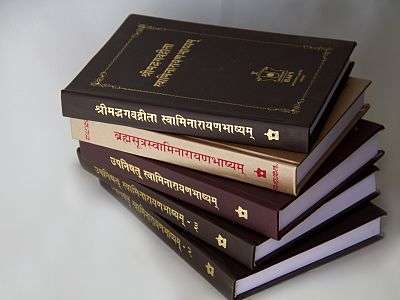
The Swaminarayan Sampradaya has produced voluminous biographical literature on Swaminarayan. The Bhaktachintamani is a sacred biography of Swaminarayan composed by one of his prominent disciples, Nishkulanand Swami. Consisting of 8,536 couplets, this biography serves as a record of Swaminarayan’s life and teachings.[56]:118 The Harililamrut is a longer biographical text in verse written by Dalpatram and published in 1907.[99]:86 The Satsangi Jeevan, a Sanskrit text of 17,627 verses was written by Shatanand Swami, while the Harilila Kalpataru, a 33,000-verse Sanskrit biographical text was written by Achintyananda Brahmchari at the suggestion of Gunatitanand Swami.[25]:203[100]:133 The sacred biographies complement the theological texts, insofar as their incidents serve as practical applications of the theology.[85]
Vedanta commentaries
From its early history, the Swaminarayan Sampradaya has also been involved in the practice of producing Sanskrit commentarial work as a way of engaging with the broader scholastic community. The classical Vedanta school of philosophy and theology is of particular import for the Swaminarayan Sampradaya, which has produced exegetical work on the three canonical Vedanta texts—the Upanishads, Brahmasutras, and the Bhagavad Gita.[29]:138–140 While Swaminarayan himself did not author a commentary on these texts, he engaged with them and their interpretations in the Vachanamrut. Since Swaminarayan’s metaphysical framework consists of five eternal entities, it differs from Ramanuja’s and that of the other commentators, and therefore forms a distinct system within the Vedanta school, known as the Akshar-Purushottam Darshan.[29]:141–142,152[101]:53
The earliest Vedanta commentarial literature in the Swaminarayan Sampradaya reflects a heavy dependence on the Vedanta systems of Ramanuja and Vallabha. Although authorship of these nineteenth-century and early twentieth-century texts[102]:120 are attributed to two of Swaminarayan’s eminent disciples, Muktanand Swami and Gopalanand Swami,[29]:142–143[102]:152 textual evidence indicates that they were composed by Vishishtadvaita scholars from southern India, who were called to Gujarat to head the Vadtal Sanskrit Pathshala.[102]:106–108, 112–113
The most comprehensive commentarial work on Vedanta in the Swaminarayan Sampradaya is the Swaminarayan Bhashya authored by Bhadreshdas Swami. It is a five-volume work written in Sanskrit and published between 2009 and 2012. The format and style of exegesis and argument conform with the classical tradition of Vedanta commentarial writing. In more than two thousand pages, the commentator Bhadreshdas Swami, offers detailed interpretations of the principal ten Upanishads, the Bhagavad Gita, and the Brahmasutras (Vedanta Sutras) that articulate Swaminarayan’s theology and philosophy.[103]
Major branches
Swaminarayan established two modes of succession: a hereditary administrative mode through a document titled the ‘Lekh’; and a spiritual mode established in the Vachanamrut, in which Swaminarayan conveyed his theological doctrines.[104] Swaminarayan described a spiritual mode of succession whose purpose is purely soteriological,[104] reflecting his principle that a form of God who lives “before one’s eyes” is necessary for aspirants to attain moksha (liberation).[105] The BAPS venerates "a lineage of akṣaragurus, or living gurus, [which] has been retroactively traced back to Gunatitanand Swami."[2]
The Lekh established two “administrative dioceses,"[106]:536 the Vadtal diocese and the Ahmedabad diocese, and appointed two acharyas to “administer his temple properties”[107] which are distributed among them.[106]:536 The first acharyas of the two dioceses were Swaminarayan’s two nephews, Raghuvir (Vadtal) and Ayodhyaprasad (Ahmedabad), whose descendants continue the hereditary line of succession.
The Laxminarayan Dev and Narnarayan Dev Gadis assert that the sole authority to ordain swamis and install sacred images rests with the acharyas.[108] However, BAPS believes that Gunatitanand Swami was appointed as successor of Swaminarayan. Thus, important rituals of the sampradaya, such as the ordaining of swamis, and the installation of sacred images in the mandirs can be performed by the guru, as authority is dictated by spiritual virtues rather than a hereditary lineage.[109]
Modes of succession
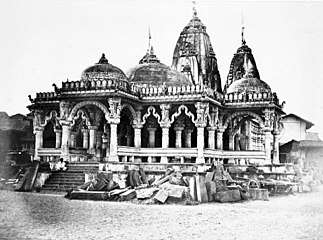
In the 20th century, due to "different interpretations of authentic successorship,"[1] the sampradaya split-up into various dominations.[2] All groups regard Swaminarayan as God but differ in their theology and the religious leadership they accept.[3][4][110]:172[6]
The Vadtal Gadi and Ahmedabad Gadi are the oldest institutions, with a hereditary leadership which appoints acharyas. The administrative succession was communicated in an administrative document, attributed to Swaminarayan, entitled the “Lekh”,[106]:536 which is important for the Nar-Narayan (Ahmedabad) and Laxmi-Narayan ((Vadtal) branches, but considered inconsequential for the spiritual succession by the other branches.[111][note 4]
Laxminarayan Gadi (Vadtal) and Narnarayan Gadi (Ahmedabad)
In 1826, Swaminarayan appointed two of his nephews as acharyas to administer the two gadis, or dioceses. Ayodhyaprasadji, son of his elder brother Rampratap, became acharya of the Nar Narayan Dev Gadi (Ahmedabad diocese), and Raghuvirji, son of his younger brother Ichcharam, became acharya of the Laxmi Narayan Dev Gadi (Vadtal diocese).[25]:37–38 In the twentieth century, several controversies involving the acharyas led to litigation resulting in restrictions on the acharyas’ authority along with schisms and the formation of new subgroups within the Swaminarayan Sampradaya.[25]:49–51 The current acharya of the Nar Narayan Dev Gadi is Koshalendraprasad Pande. The current acharya of the Laxmi Narayan Dev Gadi is Ajendraprasad Pande.[112]
Bochasanwasi Akshar Purushottam Swaminarayan Sanstha (BAPS)
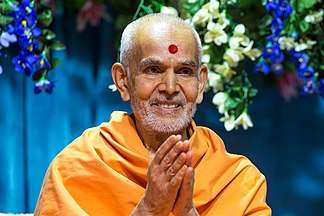
The Bochasanwasi Akshar Purushottam Swaminarayan Sanstha (BAPS) was formed in 1907, by Shastriji Maharaj (Shastri Yagnapurushdas).[25]:60–61[113] Shastriji Maharaj's primary reason for separation from the Vadtal diocese and creation of BAPS had been due to doctrinal differences in the interpretation of Akshar (Aksharbrahma) and Purushottam, regarding Gunatitanand Swami, the guru of his own guru Bhagatji Maharaj, as the manifestation of Aksharbrahm,[25]:60–61[114]:419[14]:157
As articulated in the theology of Akshar-Purushottam Darshan, followers believe Swaminarayan manifests through a lineage of Aksharbrahma Gurus, beginning with Gunatitanand Swami followed by Bhagatji Maharaj, Shastriji Maharaj, Yogiji Maharaj, Pramukh Swami Maharaj, and currently Mahant Swami Maharaj.[25]:60–62
Swaminarayan Gadi (Maninagar)
The Maninagar Swaminarayan Gadi was founded in 1941 by Muktajivandas Swami after he left the Ahmedabad diocese with the belief that Gopalanand Swami was the spiritual successor to Swaminarayan.[25]:58 The current spiritual leader is Jitendrapriyadasji Swami.[115][116]
Gunatit Samaj
The Yogi Divine Society was established in 1966, by Dadubhai Patel and his brother, Babubhai after they were excommunicated from BAPS by Yogiji Maharaj. The brothers were expelled after it was discovered that Dadubhai illicitly collected and misappropriated funds and, falsely claiming that he was acting on the organization’s behalf, led a number of young women to renounce their families and join his ashram under his leadership.[25]:72[117][118]:18–19 After Dadubhai’s death in 1986, an ascetic named Hariprasad Swami became the leader of the Yogi Divine Society. The Yogi Divine Society became known as the Gunatit Samaj and consists of several wings: namely, Yogi Divine Society, The Anoopam Mission, and The Gunatit Jyot.[25]:72–73,127[117]
Influence on society
Humanitarian Service
In addition to his efforts in social reform, Swaminarayan was instrumental in providing humanitarian aid to the people of Gujarat during turbulent times of famine.[21]:105 When given the opportunity to receive two boons from his guru, Swaminarayan asked to receive any miseries destined for followers and to bear any scarcities of food or clothing in place of any followers.[119]:192 In the initial years of the sampradaya, Swaminaryan maintained almshouses throughout Gujarat and directed swamis to maintain the almshouses even under the threat of physical injury by opponents.[120]:11–12 During a particularly harsh famine in 1813-14, Swaminarayan himself collected and distributed grains to those who were suffering, and he had step wells and water reservoirs dug in various villages.[21]:105 He codified devotees’ engagement with humanitarian service in the Shikshapatri, instructing followers to help the poor and those in need during natural disasters, to establish schools, and to serve the ill, according to their ability.[121]
Consequently, various denominations of the Swaminarayan Sampradaya currently engage in humanitarian service at a global scale. For example, BAPS has been involved with coordinating responses to major natural disasters, building various residential and day schools, organizing blood donation drives and free medical clinics as well as constructing and running seven hospitals and treatment centers through its humanitarian services wing, BAPS Charities. Following the devastating earthquake in Gujarat in 2001, they rebuilt 15 villages and neighborhoods and 39 schools.[21]:112–114 For its work, BAPS has been granted consultative status with the Economic and Social Council of the United Nations.[21]:117
ISSO Seva, a subsidiary of the Ahmedabad diocese, is involved in disaster relief, food and blood donation drives in the United States and providing accessible healthcare in Africa.[122] The Gunatit Samaj also hosts medical camps, provides educational services, healthcare, and other social services in India.[123] The Swaminarayan Gadi (Maninagar) diocese primarily hosts health camps and other social services in the UK, Africa and North America.[124] SVG Charity, a subsidiary of the Laxmi Narayan Dev Gadi, is involved in disaster relief, food and medicine donations, blood drives, and organ donation registration drives across the United States, Europe, Canada, and India.[125][126][127]
Caste
During Swaminarayan’s time, the oppressive nature of caste-based customs, like endogamy, dress codes, and commensality, pervaded many aspects of society.[56]:121 Religious groups and other institutions often regulated membership based on caste.[56]:117 Swaminarayan opposed caste-based discrimination and has been credited as one of the foremost social reformers of 19th century India for his efforts in reducing caste-based oppression. In fact, Swaminarayan’s opposition of caste-based discrimination through his spiritual teachings and practices incited vehement criticism and violence from some high-caste Hindus.[56]:122–126 Kishore Mashruwala, a Gandhian scholar writes that “Swaminarayan was the first to bring about religious advancement of Shudras in Gujarat and Kathiawad region…And that became the main reason for many to oppose the Sampraday”.[56]:122[128] It is noted in an 1823 memorandum published in The Asiatic Journal that upper-caste Hindus “regret the levelling nature of [Swaminarayan's] system” often resulting in frequent violence against followers of the Swaminarayan Sampradaya.[56]:122[129]
Swaminarayan's doctrine that everyone's true self is the pure atma within which God resides, led him to reject caste-based discrimination and welcome those of all caste backgrounds equally into the Swaminarayan Sampradaya.[56]:122–126[130]:105 In his public writings, Swaminarayan allowed for some caste rules to protect his followers from violence incited by his opposition of caste-based discrimination.[56]:122–123[130]:106–107 For example, in the Shikshapatri, Swaminarayan states that his followers should follow rules of the caste system when consuming food and water.[130]:106–107 Based on these public writings some have criticized Swaminarayan of supporting caste-based discrimination.[130]:106 However, numerous scholars have demonstrated that this criticism is unfounded, citing Swaminarayan’s continued actions in combating caste-based oppression and promoting inclusivity. In fact, Swaminarayan not only accepted people from all castes into the sampradaya but also Muslims and tribal peoples.[56]:117[129] Additionally, various historical sources indicate that Swaminarayan himself often ignored caste rules and urged his followers to do the same.[56]:122–126[130]:105–107[25]:169–173 When asked about his views on caste by Bishop Reginald Heber, Swaminarayan stated that he did not believe in the caste system but sometimes accommodated it publicly so as to not offend the masses.[56]:124–126[131]
Taken together, Swaminarayan’s contemporaries and modern scholars both credit him for reducing caste-based oppression and discrimination through his actions and teachings. Swaminarayan’s actions uplifted many of the oppressed and drew them to the Swaminarayan Sampradaya.[56]:122–126[130]:117[25]:169–173
Notes
- "Professor Ashok Aklujkar said [...] Just as the Kashi Vidvat Parishad acknowledged Swaminarayan Bhagwan’s Akshar-Purushottam Darshan as a distinct darshan in the Vedanta tradition, we are honored to do the same from the platform of the World Sanskrit Conference [...] Professor George Cardona [said] "This is a very important classical Sanskrit commentary that very clearly and effectively explains that Akshar is distinct from Purushottam."[9]
- See Gadhada I.7, Gadhada I.39, Gadhada I.42, [13]
- "Within philosophy, just as Śrī Śaṅkara’s Vedānta is identified as the Advaita Darśana, Śrī Rāmānuja’s Vedānta is identified as the Viśiṣṭādvaita Darśana, Śrī Madhva’s Vedānta is identified as the Dvaita Darśana, Śrī Vallabha’s Vedānta is identified as the Śuddhādvaita Darśana, and others are respectively known; it is in every way appropriate to identify Sri Svāminārāyaṇa’s Vedānta by the title: Akṣara-Puruṣottama Darśana."[7]
- Raymond Brady Williams, An Introduction to Swaminarayan Hinduism (3rd ed.): "The original Ahmedabad and Vadtal dioceses value the Lekh, where as those groups that emphasis the authority of the sadhus over the acharya and different lineages of gurus downplay or ignore the lekh as simply an administrative document for temporary application and not as sacred scripture. Baps emphasizes the Swamini Vato, which contains the sayings of Gunatitanand."
References
- Patel 2018.
- Kim, Hanna (2005). "Swaminarayan Movement". www.encyclopedia.com. Retrieved 15 August 2020.
- Patel 2018, p. 2.
- Paramtattvadas, Swami (2017). An introduction to Swaminarayan Hindu theology. Cambridge, United Kingdom: Cambridge University Press. ISBN 978-1-107-15867-2. OCLC 964861190.
- Warrier, Maya (2012). "Traditions and Transformations". In Zavos, John; Kanungo, Pralay; Reddy, Deepa S.; Warrier, Maya; Williams, Raymond B. (eds.). Public Hinduisms. SAGE Publications India Pvt Ltd. pp. 169–76. ISBN 978-1-283-57553-9. OCLC 808609622.
- Patel 2018a, p. 58.
- BAPS Swaminarayan Research Institute, HH Mahant Swami Maharaj Inaugurates the Svāminārāyaṇasiddhāntasudhā and Announces Parabrahman Svāminārāyaṇa’s Darśana as the Akṣara-Puruṣottama Darśana
- BAPS Swaminarayan Sanstha, Acclamation by th Sri Kasi Vidvat Parisad
- 17th World Sanskrit Conference Recognizes Bhagwan Swaminarayan’s Akshar-Purushottam Darshan as a Distinct Vedanta Tradition
- Paramtattvadas 2019, p. 40.
- Kim, Hanna (2002). Being Swaminarayan: the ontology and significance of belief in the construction of a Gujarati diaspora. UMI Dissertation Services. OCLC 452027310.
- Kim, Hanna (2014). "Svāminārāyaṇa: Bhaktiyoga and the Akṣarabrahman Guru". In Singleton, Mark; Goldberg, Ellen (eds.). Gurus of modern yoga. New York, NY: Oxford University Press. ISBN 978-0-19-993871-1. OCLC 861692270.
- Gadhada III.10; Sahajānanda, Swami (2015). The Vachanāmrut: spiritual discourses of Bhagwān Swāminārāyan. (3rd ed.) Ahmedabad: Bochasanvasi Shri Aksharpurushottama Sanstha ISBN 978-81-7526-431-1.
- Gadhia, Smit (2016). "Akshara and its four forms in Swaminarayan's doctrine". In Williams, Raymond Brady; Trivedi, Yogi (eds.). Swaminarayan Hinduism: tradition, adaptation and identity (1st ed.). New Delhi, India: Oxford University Press. ISBN 978-0-19-908657-3. OCLC 948338914.
- See Gadhada I.21, Gadhada II.28, Gadhada II.45, Gadhada II.66, Gadhada III.2, Gadhada III.7, Gadhada III.10, Sarangpur 9
Sahajānanda, Swami (2015). The Vachanāmrut: spiritual discourses of Bhagwān Swāminārāyan. (3rd ed.) Ahmedabad: Bochasanvasi Shri Aksharpurushottama Sanstha ISBN 978-81-7526-431-1. - Dave, Harshad (2004). Bhagwan Shri Swaminarayan - Part 1. Ahmedabad: Swaminarayan Aksharpith. ISBN 81-7526-211-7.
- Patel, Shruti (2017). "Beyond the Lens of Reform: Religious Culture in Modern Gujarat". The Journal of Hindu Studies. 10: 47–85. doi:10.1093/jhs/hix005.
- Trivedi, Yogi (2015). Bhagwan Swaminarayan: the story of his life (2nd ed.). Ahmedabad. ISBN 978-81-7526-594-3. OCLC 957581656.
- Patel 2018, p. 1.
- Williams, Raymond Brady (1984). A new face of Hinduism: the Swaminarayan religion. Cambridge [Cambridgeshire]: Cambridge University Press. ISBN 0-521-25454-X. OCLC 9442462.
- Brahmbhatt, Arun. "BAPS Swaminarayan community: Hinduism". Global religious movements across borders: sacred service. Burlington. ISBN 1-4094-5689-7. OCLC 872618204.
- Williams 2001, p. 55.
- Williams 2018, p. 93.
- Williams 2001, p. 55, 59-60.
- Williams, Raymond Brady (2018). An introduction to Swaminarayan Hinduism (Third ed.). Cambridge, United Kingdom: Cambridge University Press. ISBN 978-1-108-42114-0. OCLC 1038043717.
- Williams, Raymond Brady (2016). "Introduction". In Trivedi, Yogi (ed.). Swaminarayan Hinduism: tradition, adaptation and identity (1st ed.). New Delhi, India: Oxford University Press. ISBN 978-0-19-908657-3. OCLC 948338914.
- Trivedi, Yogi (2016). "Multivalent Krishna-bhakti in Premanand's Poetry". In Williams, Raymond Brady (ed.). Swaminarayan Hinduism: tradition, adaptation and identity (1st ed.). New Delhi, India: Oxford University Press. ISBN 978-0-19-908657-3. OCLC 948338914.
- Rajpurohit, Dalpat (2016). "Brahmanand and his innovations in the Barahmasa genre". In Williams, Raymond Brady; Trivedi, Yogi (eds.). Swaminarayan Hinduism: tradition, adaptation and identity (1st ed.). New Delhi, India: Oxford University Press. ISBN 978-0-19-908657-3. OCLC 948338914.
- Brahmbhatt, Arun (2016). "The Swaminarayan commentarial tradition". In Williams, Raymond Brady; Trivedi, Yogi (eds.). Swaminarayan Hinduism: tradition, adaptation and identity (1st ed.). New Delhi, India: Oxford University Press. ISBN 978-0-19-908657-3. OCLC 948338914.
- Paramtattvadas, Sadhu 2017, p. 6.
- Paramtattvadas, Sadhu 2017, p. 13-4, 45.
- Paramtattvadas, Sadhu 2017, p. 272-84.
- Bhadreshdas, Sadhu; Aksharananddas, Sadhu (1 April 2016), "Swaminarayan's Brahmajnana as Aksarabrahma-Parabrahma-Darsanam", Swaminarayan Hinduism, Oxford University Press, pp. 172–190, doi:10.1093/acprof:oso/9780199463749.003.0011, ISBN 978-0-19-946374-9
- Brahmbhatt 2016.
- Paramtattvadas, Sadhu 2017, p. 69-71.
- See Gadhada I.7, Gadhada I.39, Gadhada I.42, Gadhada III.10
Sahajānanda, Swami (2015). The Vachanāmrut: spiritual discourses of Bhagwān Swāminārāyan. (3rd ed.) Ahmedabad: Bochasanvasi Shri Aksharpurushottama Sanstha ISBN 978-81-7526-431-1. - See Gadhada I.71, Loya 4, Kariyani 10, Vartal 19
Sahajānanda, Swami (2015). The Vachanāmrut: spiritual discourses of Bhagwān Swāminārāyan. (3rd ed.) Ahmedabad: Bochasanvasi Shri Aksharpurushottama Sanstha ISBN 978-81-7526-431-1. - See Gadhada II.9, Gadhada II.13, Gadhada III.38, Amdavad 6, Amdavad 7
Sahajānanda, Swami (2015). The Vachanāmrut: spiritual discourses of Bhagwān Swāminārāyan. (3rd ed.) Ahmedabad: Bochasanvasi Shri Aksharpurushottama Sanstha ISBN 978-81-7526-431-1. - Paramtattvadas, Sadhu 2017, p. 158, 200-1.
- Kim, Hanna. "Devotional expressions in the Swaminarayan community". In Kumar, P. Pratap (ed.). Contemporary Hinduism. Durham, UK. ISBN 978-1-84465-690-5. OCLC 824353503.
- Paramtattvadas, Sadhu 2017, p. 71-3,245.
- See Gadhada I.13, Gadhada III.10, Loya 17
Sahajānanda, Swami (2015). The Vachanāmrut: spiritual discourses of Bhagwān Swāminārāyan. (3rd ed.) Ahmedabad: Bochasanvasi Shri Aksharpurushottama Sanstha ISBN 978-81-7526-431-1. - Paramtattvadas, Sadhu 2017, p. 71,246.
- See Loya 10
Sahajānanda, Swami (2015). The Vachanāmrut: spiritual discourses of Bhagwān Swāminārāyan. (3rd ed.) Ahmedabad: Bochasanvasi Shri Aksharpurushottama Sanstha ISBN 978-81-7526-431-1. - Paramtattvadas, Sadhu 2017, p. 245, 249-50.
- Kim, Hanna (2016). "Thinking through Akshardham and the making of the Swaminarayan self". In Williams, Raymond Brady; Trivedi, Yogi (eds.). Swaminarayan Hinduism: tradition, adaptation and identity (1st ed.). New Delhi, India: Oxford University Press. ISBN 978-0-19-908657-3. OCLC 948338914.
- See Gadhada I.13, Gadhada I.1, Gadhada II.36, Gadhada III.39
Sahajānanda, Swami (2015). The Vachanāmrut: spiritual discourses of Bhagwān Swāminārāyan. (3rd ed.) Ahmedabad: Bochasanvasi Shri Aksharpurushottama Sanstha ISBN 978-81-7526-431-1. - Paramtattvadas, Sadhu 2017, p. 238-41.
- See Gadhada II.31, Gadhada II.66, Gadhada III.38, Sarangpur 1, Panchala 4
Sahajānanda, Swami (2015). The Vachanāmrut: spiritual discourses of Bhagwān Swāminārāyan. (3rd ed.) Ahmedabad: Bochasanvasi Shri Aksharpurushottama Sanstha ISBN 978-81-7526-431-1. - Paramtattvadas, Sadhu 2017, p. 234-5.
- See Gadhada II.31, Kariyani 12, Sarangpur 5, Panchala 2
Sahajānanda, Swami (2015). The Vachanāmrut: spiritual discourses of Bhagwān Swāminārāyan. (3rd ed.) Ahmedabad: Bochasanvasi Shri Aksharpurushottama Sanstha ISBN 978-81-7526-431-1. - Paramtattvadas, Sadhu 2017, p. 211-8.
- See Gadhada I.21, Gadhada I.44, Gadhada III.22, Gadhada III.39, Jetalpur 2
Sahajānanda, Swami (2015). The Vachanāmrut: spiritual discourses of Bhagwān Swāminārāyan. (3rd ed.) Ahmedabad: Bochasanvasi Shri Aksharpurushottama Sanstha ISBN 978-81-7526-431-1. - See Gadhada I.21, Gadhada II.28, Gadhada II.45, Gadhada II.66, Gadhada III.2, Gadhada III.7, Gadhada III.10, Sarangpur 9
Sahajānanda, Swami (2015). The Vachanāmrut: spiritual discourses of Bhagwān Swāminārāyan. (3rd ed.) Ahmedabad: Bochasanvasi Shri Aksharpurushottama Sanstha ISBN 978-81-7526-431-1. - See Gadhada II.50, Gadhada III.39, Kariyani 12
Sahajānanda, Swami (2015). The Vachanāmrut: spiritual discourses of Bhagwān Swāminārāyan. (3rd ed.) Ahmedabad: Bochasanvasi Shri Aksharpurushottama Sanstha ISBN 978-81-7526-431-1. - Mangalnidhidas, Sadhu (2016). "Sahajanand Swami's approach to caste". In Williams, Raymond Brady; Trivedi, Yogi (eds.). Swaminarayan Hinduism: tradition, adaptation and identity (1st ed.). New Delhi, India: Oxford University Press. ISBN 978-0-19-908657-3. OCLC 948338914.
- See Gadhada II.21, Gadhada III.21, Sarangpur 11
Sahajānanda, Swami (2015). The Vachanāmrut: spiritual discourses of Bhagwān Swāminārāyan. (3rd ed.) Ahmedabad: Bochasanvasi Shri Aksharpurushottama Sanstha ISBN 978-81-7526-431-1. - See Gadhada II.20
Sahajānanda, Swami (2015). The Vachanāmrut: spiritual discourses of Bhagwān Swāminārāyan. (3rd ed.) Ahmedabad: Bochasanvasi Shri Aksharpurushottama Sanstha ISBN 978-81-7526-431-1. - Paramtattvadas 2017, p. 3.
- Swaminarayan's teachings, p. 40.
- Williams 2018, p. 30.
- Paramtattvadas, Sadhu 2017, p. 150.
- Paramtattvadas, Sadhu 2017, p. 287.
- See Sarangpur 11, Gadhada II.21, and Gadhada III.21
Sahajānanda, Swami (2015). The Vachanāmrut: spiritual discourses of Bhagwān Swāminārāyan. (3rd ed.) Ahmedabad: Bochasanvasi Shri Aksharpurushottama Sanstha ISBN 978-81-7526-431-1. - Lagassé, Paul (2013). "Dharma". The Columbia encyclopedia (6th ed.). New York: Columbia University Press. ISBN 978-0-7876-5015-5. OCLC 43599122.CS1 maint: date and year (link)
- Vivekjivandas, Sadhu (2016). "Transnational growth of BAPS in East Africa". In Williams, Raymond Brady; Trivedi, Yogi (eds.). Swaminarayan Hinduism: tradition, adaptation and identity. Patel, Mahendra; Iswarcharandas, Sadhu (1st ed.). New Delhi, India: Oxford University Press. ISBN 978-0-19-908657-3. OCLC 948338914.
- Kurien, Prerna (2007). A place at the multicultural table: the development of an American Hinduism. Piscataway: Rutgers University Press. ISBN 978-0-8135-4161-7. OCLC 476118265.
- Paramtattvadas, Sadhu 2017, p. 62.
- See Gadhada II.51 Sahajānanda, Swami (2014). The Vachanāmrut: spiritual discourses of Bhagwān Swāminārāyan. Bochasanvasi Shri Aksharpurushottama Sanstha (First ed.). Ahmedabad. ISBN 978-81-7526-431-1. OCLC 820357402.
- Paramtattvadas, Sadhu 2017, p. 61-62.
- See Gadhada III.34
Sahajānanda, Swami (2015). The Vachanāmrut: spiritual discourses of Bhagwān Swāminārāyan. (3rd ed.) Ahmedabad: Bochasanvasi Shri Aksharpurushottama Sanstha ISBN 978-81-7526-431-1. - Paramtattvadas, Sadhu 2017, p. 151.
- See Panchala 9
Sahajānanda, Swami (2015). The Vachanāmrut: spiritual discourses of Bhagwān Swāminārāyan. (3rd ed.) Ahmedabad: Bochasanvasi Shri Aksharpurushottama Sanstha ISBN 978-81-7526-431-1. - Williams, Raymond Brady (1998). "Training religious specialists for a transnational Hinduism: A Swaminarayan sadhu training center". Journal of the American Academy of Religion. 66 (4): 841–862. doi:10.1093/jaarel/66.4.841.
- Mosher, Lucinda Allen. (2006). Praying. New York, N.Y.: Seabury Books. ISBN 1-59627-016-0. OCLC 63048497.
- Bhatt, Kalpesh. "Daily pūjā: moralizing dharma in the BAPS Swaminarayan Hindu tradition". Nidan: International Journal for Indian Studies: 88–109.
- Kim, Hanna (2007). "Edifice complex: Swaminarayan bodies and buildings in the diaspora". Gujaratis in the West: evolving identities in contemporary society. Mukadam, Anjoom A., Mawani, Sharmina. Newcastle, UK: Cambridge Scholars Pub. ISBN 978-1-84718-368-2. OCLC 233491089.
- Vasavada, Rabindra (2016). "Swaminarayan temple building". In Williams, Raymond Williams; Trivedi, Yogi (eds.). Swaminarayan Hinduism: tradition, adaptation and identity (1st ed.). New Delhi, India: Oxford University Press. ISBN 978-0-19-908657-3. OCLC 948338914.
- Kim, Hanna H., "Public Engagement and Personal Desires: BAPS Swaminarayan Temples and their Contribution to the Discourses on Religion" (2010). Anthropology Faculty Publications.
- Packert, Cynthia (2019). "From Gujarat to the globe: 'Bhakti visuality' and identity in BAPS Svāminārāyaṇ Hinduism". International Journal of Hindu Studies. 12 (2): 192–223. doi:10.1093/jhs/hiz013.
- Packert, Cynthia (2016). "Early Swaminarayan iconography and its relationship to Vaishnavism". In Williams, Raymond Williams; Trivedi, Yogi (eds.). Swaminarayan Hinduism: tradition, adaptation and identity (1st ed.). New Delhi, India: Oxford University Press. ISBN 978-0-19-908657-3. OCLC 948338914.
- Paramtattvadas, Sadhu 2017, p. 124-130.
- Trivedi, Yogi (2016). "Introduction to the arts and architecture". Swaminarayan Hinduism: tradition, adaptation and identity. Williams, Raymond Brady., Trivedi, Yogi. (1st ed.). New Delhi, India: Oxford University Press. ISBN 978-0-19-908657-3. OCLC 948338914.
- Kim, Hanna. "Steeples and spires: exploring the materiality of built and unbuilt temples". Nidan - International Journal for the Study of Hinduism. 23.
- Paramtattvadas, Sadhu 2017, p. 64.
- Paramtattvadas, Sadhu 2017, p. 47.
- Trivedi, Yogi (2016). "Introduction to theology and literature". In Williams, Raymond Brady; Trivedi, Yogi (eds.). Swaminarayan Hinduism: tradition, adaptation and identity (1st ed.). New Delhi, India: Oxford University Press. ISBN 978-0-19-908657-3. OCLC 948338914.
- Paramtattvadas, Sadhu 2017, p. 14.
- Paramtattvadas, Sadhu 2017, p. 333.
- Paramtattvadas, Sadhu 2017, p. 69.
- See Sarangpur 11
Sahajānanda, Swami (2015). The Vachanāmrut: spiritual discourses of Bhagwān Swāminārāyan. Bochasanvasi Shri Aksharpurushottama Sanstha. (3rd ed.). Ahmedabad. ISBN 978-81-7526-431-1. OCLC 820357402. - Paramtattvadas, Sadhu 2017, p. 273.
- See Gadhada III-39
Sahajānanda, Swami (2015). The Vachanāmrut: spiritual discourses of Bhagwān Swāminārāyan. Bochasanvasi Shri Aksharpurushottama Sanstha. (3rd ed.). Ahmedabad. ISBN 978-81-7526-431-1. OCLC 820357402. - Paramtattvadas, Sadhu 2017, p. 303-4.
- Brear, Douglas (1996). Williams, Raymond Brady (ed.). Transmission of a Swaminarayan Hindu scripture in the British East Midlands (Columbia University Press ed.). New York: Columbia University Press. ISBN 0-231-10779-X. OCLC 34984234.
- Paramtattvadas, Sadhu 2017, p. 16.
- Mamtora, Bhakti. The making of a modern scripture: Svāmīnī Vāto and the formation of religious subjectivities in Gujarat. PhD diss., (University of Florida, 2019)
- Paramtattvadas, Sadhu 2017, p. 17.
- Amrutvijaydas, Swami; Paramtattvadas, Swami; Williams, Raymond Brady (2016). "Swaminarayan and British contacts in Gujarat in the 1820s". In Williams, Raymond Brady; Trivedi, Yogi (eds.). Swaminarayan Hinduism: tradition, adaptation and identity (1st ed.). New Delhi, India: Oxford University Press. ISBN 978-0-19-908657-3. OCLC 948338914.
- Dave, Jyotindra (2018). "The tradition of education within the Swaminarayan Sampraday". Journal of the BAPS Swaminarayan Research Institute. 1.
- Bhadreshdas, Sadhu (2018). "Parabrahman Swaminarayan's Akshara-Purushottama Darshana". Journal of the BAPS Swaminarayan Research Institute. 1.
- Brahmbhatt, Arun. Scholastic Publics: Sanskrit textual practices in Gujarat, 1800-Present. PhD diss., (University of Toronto, 2018)
- Paramtattvadas, Sadhu 2017, p. 19.
- Paramtattvadas, Sadhu 2017, p. 132-156.
- Paramtattvadas, Sadhu 2017, p. 134.
- Cush, Denise; Robinson, Catherine; York, Michael (2008). Encyclopedia of Hinduism. London: Routledge. ISBN 978-0-7007-1267-0. OCLC 62133001.
- Patel, Iva (2018), Jain, Pankaj; Sherma, Rita; Khanna, Madhu (eds.), "Swaminarayan", Hinduism and Tribal Religions, Dordrecht: Springer Netherlands, pp. 1–6, doi:10.1007/978-94-024-1036-5_541-1, ISBN 978-94-024-1036-5, retrieved 15 August 2020
- Williams 2001, p. 59.
- Williams 2001, p. 59-60.
- Warrier, Maya (2012). "Traditions and Transformations". In Zavos, John; Kanungo, Pralay; Reddy, Deepa S.; Warrier, Maya; Williams, Raymond B. (eds.). Public Hinduisms. SAGE Publications India Pvt Ltd. pp. 169–76. ISBN 978-1-283-57553-9. OCLC 808609622.
- Dave, J. M. 1997. Reappraisal of the “Lekh”. In Mehta R. N., Chandra D., Trivedi M. R. and Ganorkar B. (eds) New dimensions of Indology. Delhi: Bharatiya Vidya Prakashan, pp. 284–95
- Dec 15, TNN /; 2018; Ist, 07:58. "Gujarat high court pulls up Swaminarayan sect trust for 'proxy war' | Ahmedabad News - Times of India". The Times of India. Retrieved 15 August 2020.CS1 maint: numeric names: authors list (link)
- Paramtattvadas, Sadhu 2017, p. 22.
- Kim, Hanna (2012). "The BAPS Swaminarayan temple organisation and its publics". Public Hinduisms. Zavos, John. Thousand Oaks, Calif.: SAGE Publications. ISBN 978-81-321-1069-9. OCLC 808372546.
- Jul 12, Ahmedabad Mirror / Updated:; 2020; Ist, 18:52. "Maninagar Swaminarayan Gadi Sansthan gets new heir". Ahmedabad Mirror. Retrieved 28 July 2020.CS1 maint: extra punctuation (link) CS1 maint: numeric names: authors list (link)
- Jul 13, TNN |; 2020; Ist, 04:52. "New head of Maninagar Swaminarayan temple announced | Ahmedabad News - Times of India". The Times of India. Retrieved 28 July 2020.CS1 maint: numeric names: authors list (link)
- Melton, J. Gordon (21–23 June 2011). New New Religions in North America: The Swaminarayan Family of Religions (PDF). Annual Meeting of the Center for Studies of New Religions (CESNUR).
- Swaminarayan Prakash. June 1966. Mumbai (Dadar): Akshar Bhavan.
- Beckerlegge, Gwilym (2006). Swami Vivekananda's Legacy of Service: A Study of the Ramakrishna Math and Mission. Oxford University Press. ISBN 978-0-19-567388-3.
- Dani, Gunvant (1980). Bhagwan Swaminarayan, a social reformer. Bochasanwasi Shri Aksharpurushottam Sanstha. OCLC 500188660.CS1 maint: date and year (link)
- Parekh, Manilal Chhotala (1936). Sri Swami Narayana a gospel of Bhagwat-dharma or God in redemptive action. Sri Bhagwat-Dharma Mission House (Harmony House). OCLC 1073620532.
- "ISSO Seva". issoseva.org. Retrieved 3 May 2020.
- "Index of /activities". www.anoopam-mission.org. Retrieved 3 May 2020.
- Sansthan, Maninagar Shree Swaminarayan Gadi. "Maninagar Shree Swaminarayan Gadi". swaminarayangadi.com. Retrieved 3 May 2020.
- "Charity". Swaminarayan Vadtal Gadi - SVG. 20 March 2014. Retrieved 3 May 2020.
- "Golden Book of World Records Largest Number of Eye Donation Registrations in One Hour". Retrieved 3 May 2020.
- "Golden Book of World Records Largest Number of Body Donation Registrations in Twelve Hours". Retrieved 3 May 2020.
- Mashruwala, Kishore (1940). Sahajanand Swami and Swaminarayan Sampradaya (2 ed.). Ahmedabad: Navajivan Publishing House.
- N.A. (1823). "Indian Sect: Memorandum Respecting a Sect Lately Introduced by a Person Calling Himself Swamee Naraen". The Asiatic Journal and Monthly Register for British India and Its Dependencies. Kingsbury, Parbury and Allen. XV: 348–349.
- Parikh, Vibhuti (1 April 2016), "The Swaminarayan Ideology and Kolis in Gujarat", in Williams, Raymond Brady; Trivedi, Yogi (eds.), Swaminarayan Hinduism, Oxford University Press, pp. 94–114, doi:10.1093/acprof:oso/9780199463749.003.0006, ISBN 978-0-19-946374-9, retrieved 7 June 2020
- Heber, Reginald (1828). Narrative Of A Journey Through The Upper Provinces Oof India, From Calcutta To Bombay, 1824-1825, (With Notes Upon Ceylon) : An Account Of A Journey Tto Madras And The Southern Provinces, 1826, And Letters Written In India; In Three Volumes. Gilbert. OCLC 554124407.
Sources
- Printed sources
- Brahmbhatt, Arun (2016), "The Swaminarayan Commentarial Tradition", in Williams, Raymond Brady; Yogi Trivedi (eds.), Swaminarayan Hinduism: Tradition, Adaptation, and Identity, Oxford University Press
- Jacobs, Stephen (2010), Hinduism Today: An Introduction, A&C Black
- Kim, Hanna H. (2005), "Swaminarayan movement", MacMillan Encyclopedia of Religion
- Paramtattvadas, Sadhu (17 August 2017). An introduction to Swaminarayan Hindu theology. Cambridge, United Kingdom: Cambridge University Press. ISBN 978-1-107-15867-2. OCLC 964861190.
- Paramtattvadas, Swami (October–December 2019). "Akshar-Purushottam School of Vedanta". Hinduism Today. Himalayan Academy. Retrieved 22 November 2019.
- Patel, Shruti (2017), "Beyond the Lens of Reform: Religious Culture in Modern Gujarat", The Journal of Hindu Studies 2017; 10:47-85
- Patel, Iva (2018), "Swaminarayan", in Jain, P.; Sherma, R.; Khanna, M. (eds.), Hinduism and Tribal Religions. Encyclopedia of Indian Religions, Springer, Dordrecht
- Patel, Aarti (2018a). "Secular Conflict". Nidān: International Journal for Indian Studies. 3 (2): 55–72.
- Tripathy, Preeti (2010). Indian religions: tradition, history and culture. New Delhi, India: Axis Publications. ISBN 978-93-80376-17-2. OCLC 436980135.
- Williams, Raymond (2001). An Introduction to Swaminarayan Hinduism. United Kingdom: Cambridge University Press. ISBN 978-0-521-65422-7.
- Williams, Raymond Brady (2018), Introduction to Swaminarayan Hinduism (3rd ed.), Cambridge University Press
- Web-sources
External links
- Bochasanwasi Shri Akshar Purushottam Swaminarayan Sanstha (BAPS Swaminarayan Sanstha)
- Shri NarNarayan Dev Gadi (Ahmedabad)
- Shri LaxmiNarayan Dev Gadi (Vadtal)
- Maninagar Shree Swaminarayan Gadi Sansthan Gadi
- Gunatit Samaj
| Wikimedia Commons has media related to Swaminarayan Sampraday. |


